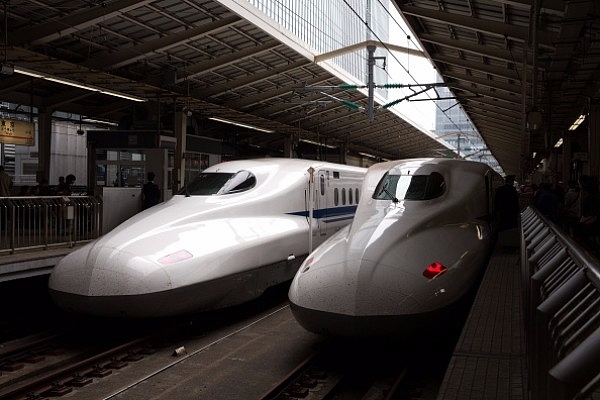
Why India’s First Bullet Train Project May Not Be A Good News For Airlines
The standard-class fare, on India’s first high-speed train from Ahmedabad and Mumbai, will surely give airlines a run for their money.
The standard-class fare between Ahmedabad and Mumbai on India’s first high-speed train would be around Rs 3,000. There could be further discounts, given the National High Speed Rail Corporation (NHSRC) is quite likely to conduct several “marketing” initiatives on the fares. Strictly speaking, the high-speed rail (HSR) fares wouldn’t be subsidised, unlike the fares on regular Indian Railways trains, but the standard-class fare being envisaged for this journey will surely give airlines a run for their money. Whether the math will work out for India’s showpiece bullet train project eventually is another story, but for now, suffice it to say that for passengers at least, this project could be a boon.
The high-speed train service is expected to become operational by August 2022, with coaches which have about 750 seats. In all 70 return journeys have been planned each day. As the project is envisaged now, the NHSRC is expecting a 4 per cent financial rate of return and an operating ratio of 96 per cent by targeting Rs 3 crore earning each day. Operating ratio is the money spent to earn every Rs 100, and the lower this ratio, the better it is for the high-speed train project.
Why would airlines bear the brunt? NHSRC managing director Achal Khare listed out three reasons for this train journey to be far more popular than a flight:
- The train frequency would be every 20-30 minutes against only a handful of flights available between the city pair daily.
- The train would obviously also allow commute to smaller stations between the start and end points – something no airline can offer. So for example, the fare between the Bandra Kurla Complex (BKC) and Thane would be about Rs 250 – a distance where app-based taxis charge anywhere between Rs 600-800. Besides, the time taken by the train to reach Thane from BKC would be a fraction of the time commuters have to spend now, travelling by road.
- Standard-class fares (the train coaches would have twin classes, including business) compare quite favourably with airline ticket prices between Ahmedabad and Mumbai. A random search on travel websites for a Mumbai-Ahmedabad journey this Saturday, for example, throws up fares between Rs 2,575 to Rs 11,794 for different times of the day, on different airlines.
“Airlines will face stiff competition from us. Historically, the airline business has plunged 50-60 per cent wherever high speed rail has started. As per the willingness-to-pay study and other factors, we expect a fare of Rs 3,000 between Ahmedabad and Mumbai. Shorter distances will have lower fare slabs,” Khare said.
Will this project then be one of the cheapest bullet train rides anywhere in the world? Khare gave the example of the Taiwan High Speed Rail project and said that the airline traffic has suffered on the routes where the HSR operates in Taiwan. While the airlines getting a hit may be true, what has also happened is that the project has had to be bailed out by the government as it was nearing bankruptcy due to lower than expected traffic, high project cost etc.
How will India’s bullet train project, built with the same technology used by Taiwan and under a loan from Japan, fare? Remember, the Indian Railways has not really had robust financials for last several years, largely because it subsidises passenger fares by charging much higher for carrying freight and this cross subsidy has resulted in lower freight carriage, further impacting financials. Some sector experts have already cast doubts over our HSR project, saying traffic and earnings projections are optimistic and the loan conditions not conducive. Both these points have been rejected by the NHSRC, which has been at pains to showcase the loan terms as beneficial to India and it has also projected sufficient traffic to realise its own earnings projections.
Meanwhile, construction for this high-speed train project will begin in January next year as the NHSRC hopes to complete land acquisition for the purpose by then. The project requires 1,415 hectares in Maharashtra and Gujarat at a cost of Rs 10,000 crore (based on the circle rate).
Khare said to emulate the kind of safety and punctuality parameters the Japanese (who have provided technology and loans for the project) are known for, 360 NHSRC employees would be trained in Japan on these aspects. The training modules will range from three to nine months.
As this story says, the Japanese did not hesitate to apologise publicly when a train left just 20 seconds early, given their emphasis on punctuality. Will this level of punctuality be a hallmark of the Indian HSR project? Khare said employees will be trained extensively on customer interface, punctuality and maintenance.